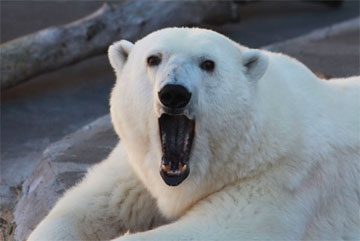Once thought of as a doomed species, new research published in the journal Nature and conducted by scientists from several institutions, including the National Science Foundation and the U.S. Geological Survey, finds that polar bears could be saved from extinction – if certain measures are taken.
The species was listed as threatened in 2007 when it became apparent that the ice floes upon which they depend were melting due to greenhouse gas emissions. Researchers then projected that one-third of the global polar bear population would be gone by mid-century. However, those projections didn’t take into account the possibility that emissions could be reduced.
“What we projected in 2007 was based solely on the business-as-usual greenhouse gas scenario,” said Steven Amstrup, an emeritus researcher at the USGS and senior scientist at Polar Bears International. “That was a pretty dire outlook, but it didn’t consider the possibility of greenhouse gas mitigation.”
 Photo by Rhett A. Butler |
The study indicates that if emissions are substantially reduced within the next two decades, enough ice will exist to support stable polar bear populations.
“Our current research provides strong evidence that it’s not too late to save polar bears from extinction,” said Eric DeWeaver, an atmospheric scientist at NSF. “We looked for Arctic sea ice tipping points in a climate model in which sea ice is known to be very sensitive to global warming, and we didn’t find any.”
Polar bears depend on ice in order to hunt their main food source: ringed and bearded seals. The ice allows the bears access to the seal’s habitat. During ice-free seasons, the bears go without food, losing up to 2lbs/day.
The new research combined many factors including polar bear life history and the natural volatility of oceanic ice to create a more comprehensive look at the arctic environment.
“Ultimately the outcome depends on how much greenhouse gas we add to the atmosphere in the future,” says DeWeaver, “not how much we’ve added until now.”
Dr. Armstrup cautions that these new predictions cannot come true unless major changes occur.
“There’s still a fairly high probability in both those regions that polar bears could disappear,” says Amstrup, “But with mitigation and aggressive management of hunting and other direct bear-human interactions, the probability of extinction would now be lower than the probability that polar bear numbers will simply be reduced.”
“Our research offers a very promising, hopeful message,” says Cecelia Bitz, of the University of Washington, “But it’s also an incentive for mitigating greenhouse emissions.”
Related articles







